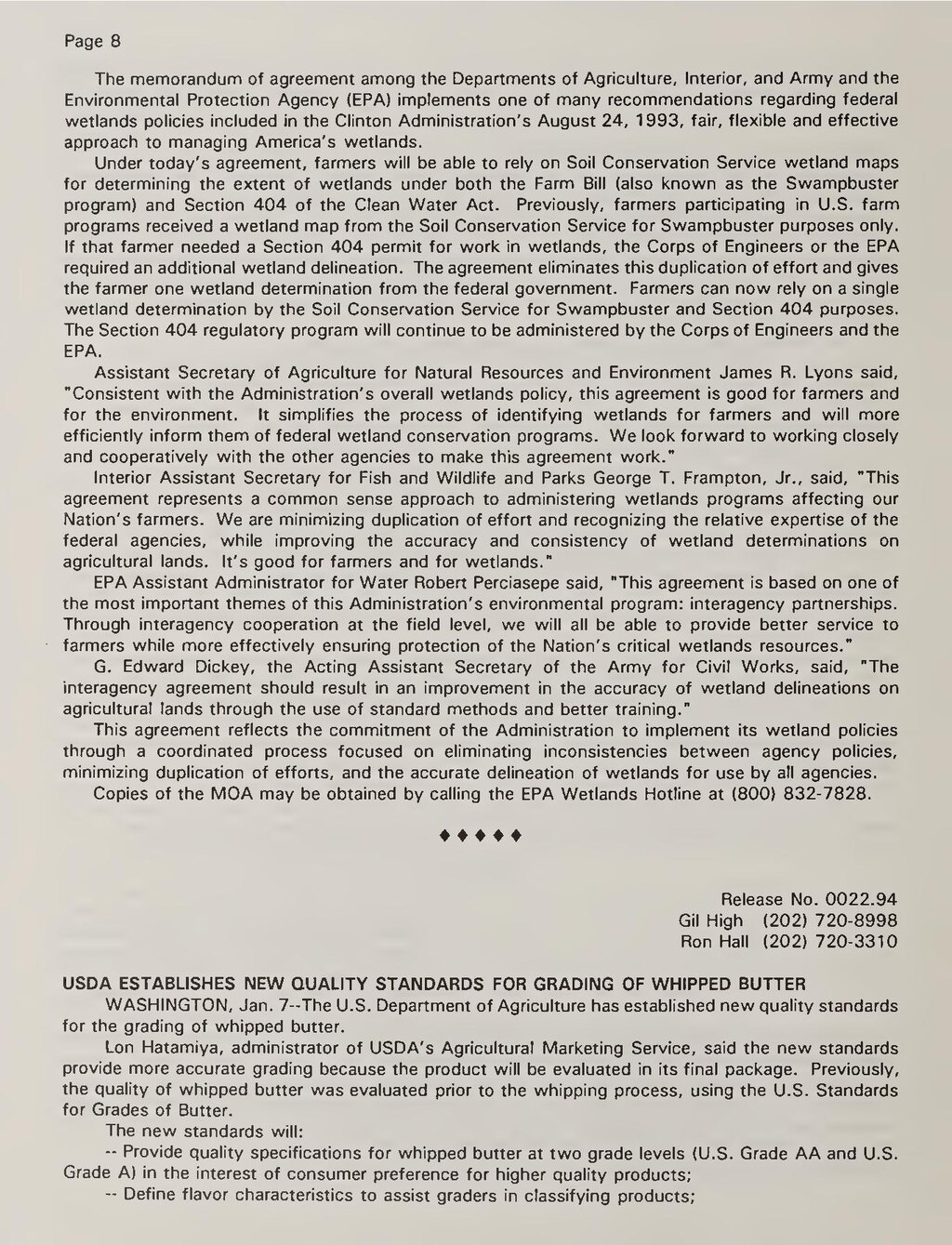The memorandum of agreement among the Departments of Agriculture, Interior, and Army and the Environmental Protection Agency (EPA) implements one of many recommendations regarding federal wetlands policies included in the Clinton Administration's August 24, 1993, fair, flexible and effective approach to managing America's wetlands.
Under today's agreement, farmers will be able to rely on Soil Conservation Service wetland maps for determining the extent of wetlands under both the Farm Bill (also known as the Swampbuster program) and Section 404 of the Clean Water Act. Previously, farmers participating in U.S. farm programs received a wetland map from the Soil Conservation Service for Swampbuster purposes only. If that farmer needed a Section 404 permit for work in wetlands, the Corps of Engineers or the EPA required an additional wetland delineation. The agreement eliminates this duplication of effort and gives the farmer one wetland determination from the federal government. Farmers can now rely on a single wetland determination by the Soil Conservation Service for Swampbuster and Section 404 purposes. The Section 404 regulatory program will continue to be administered by the Corps of Engineers and the EPA.
Assistant Secretary of Agriculture for Natural Resources and Environment James R. Lyons said, "Consistent with the Administration's overall wetlands policy, this agreement is good for farmers and for the environment. It simplifies the process of identifying wetlands for farmers and will more efficiently inform them of federal wetland conservation programs. We look forward to working closely and cooperatively with the other agencies to make this agreement work."
Interior Assistant Secretary for Fish and Wildlife and Parks George T. Frampton, Jr., said, "This agreement represents a common sense approach to administering wetlands programs affecting our Nation's farmers. We are minimizing duplication of effort and recognizing the relative expertise of the federal agencies, while improving the accuracy and consistency of wetland determinations on agricultural lands. It's good for farmers and for wetlands."
EPA Assistant Administrator for Water Robert Perciasepe said, "This agreement is based on one of the most important themes of this Administration's environmental program: interagency partnerships. Through interagency cooperation at the field level, we will all be able to provide better service to farmers while more effectively ensuring protection of the Nation's critical wetlands resources."
G. Edward Dickey, the Acting Assistant Secretary of the Army for Civil Works, said, "The interagency agreement should result in an improvement in the accuracy of wetland delineations on agricultural lands through the use of standard methods and better training."
This agreement reflects the commitment of the Administration to implement its wetland policies through a coordinated process focused on eliminating inconsistencies between agency policies, minimizing duplication of efforts, and the accurate delineation of wetlands for use by all agencies.
Copies of the MOA may be obtained by calling the EPA Wetlands Hotline at (800) 832-7828.
♦ ♦ ♦ ♦ ♦
Release No. 0022.94
Gil High (202) 720-8998
Ron Hall (202) 720-3310
USDA ESTABLISHES NEW QUALITY STANDARDS FOR GRADING OF WHIPPED BUTTER
WASHINGTON, Jan. 7--The U.S. Department of Agriculture has established new quality standards for the grading of whipped butter.
Lon Hatamiya, administrator of USDA's Agricultural Marketing Service, said the new standards provide more accurate grading because the product will be evaluated in its final package. Previously, the quality of whipped butter was evaluated prior to the whipping process, using the U.S. Standards for Grades of Butter.
The new standards will:
- -- Provide quality specifications for whipped butter at two grade levels (U.S. Grade AA and U.S. Grade A) in the interest of consumer preference for higher quality products;
- -- Define flavor characteristics to assist graders in classifying products;
